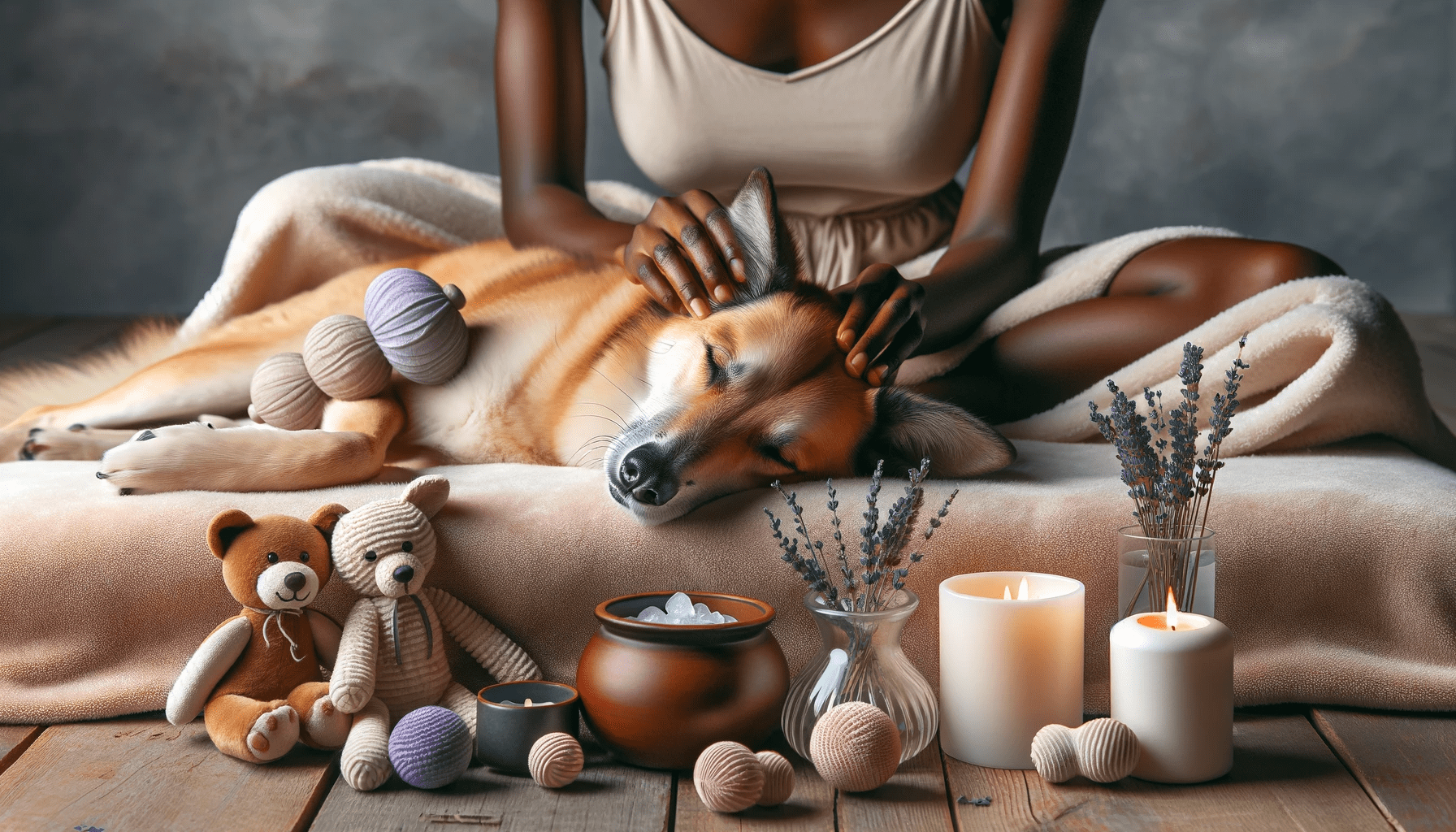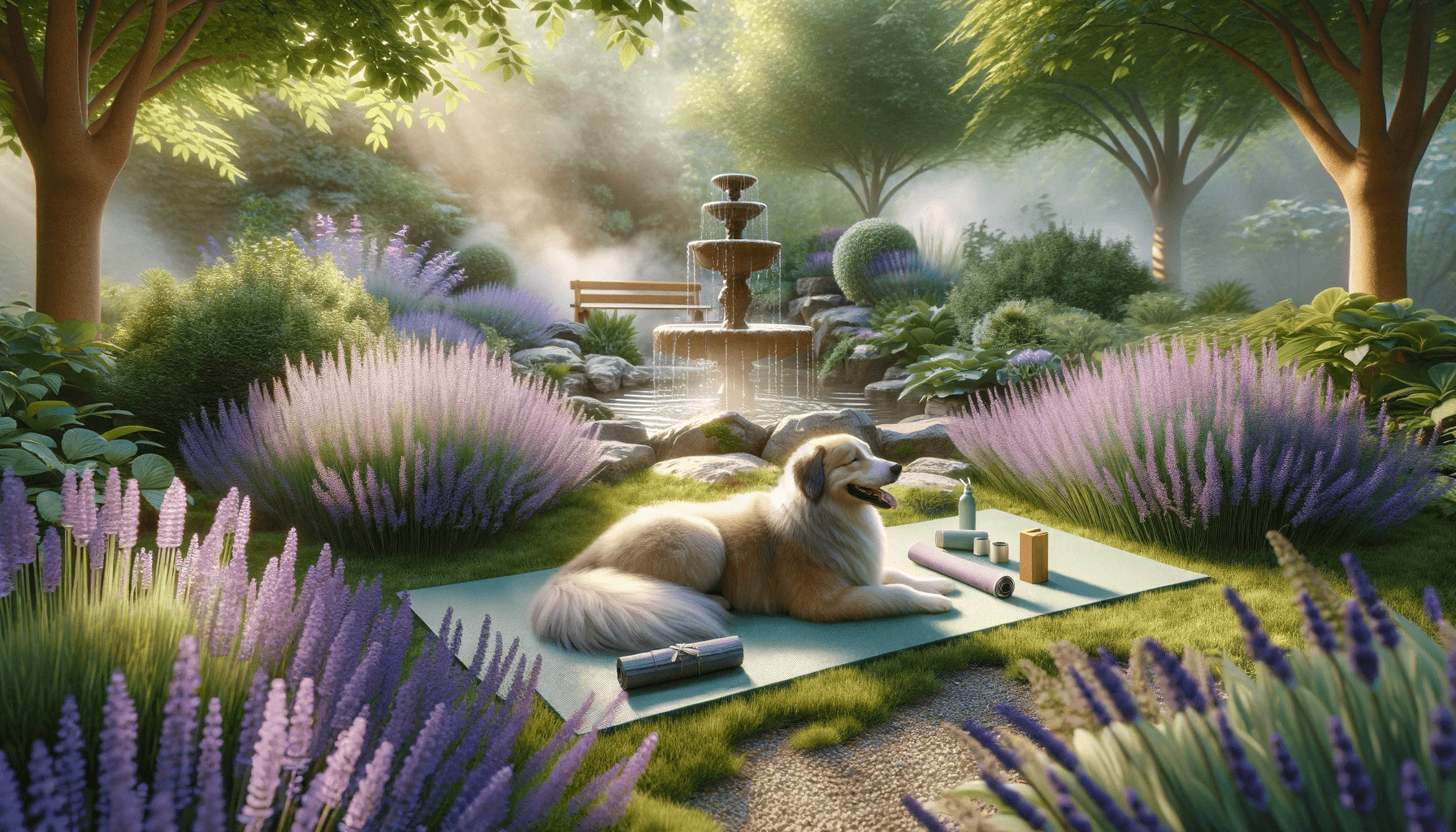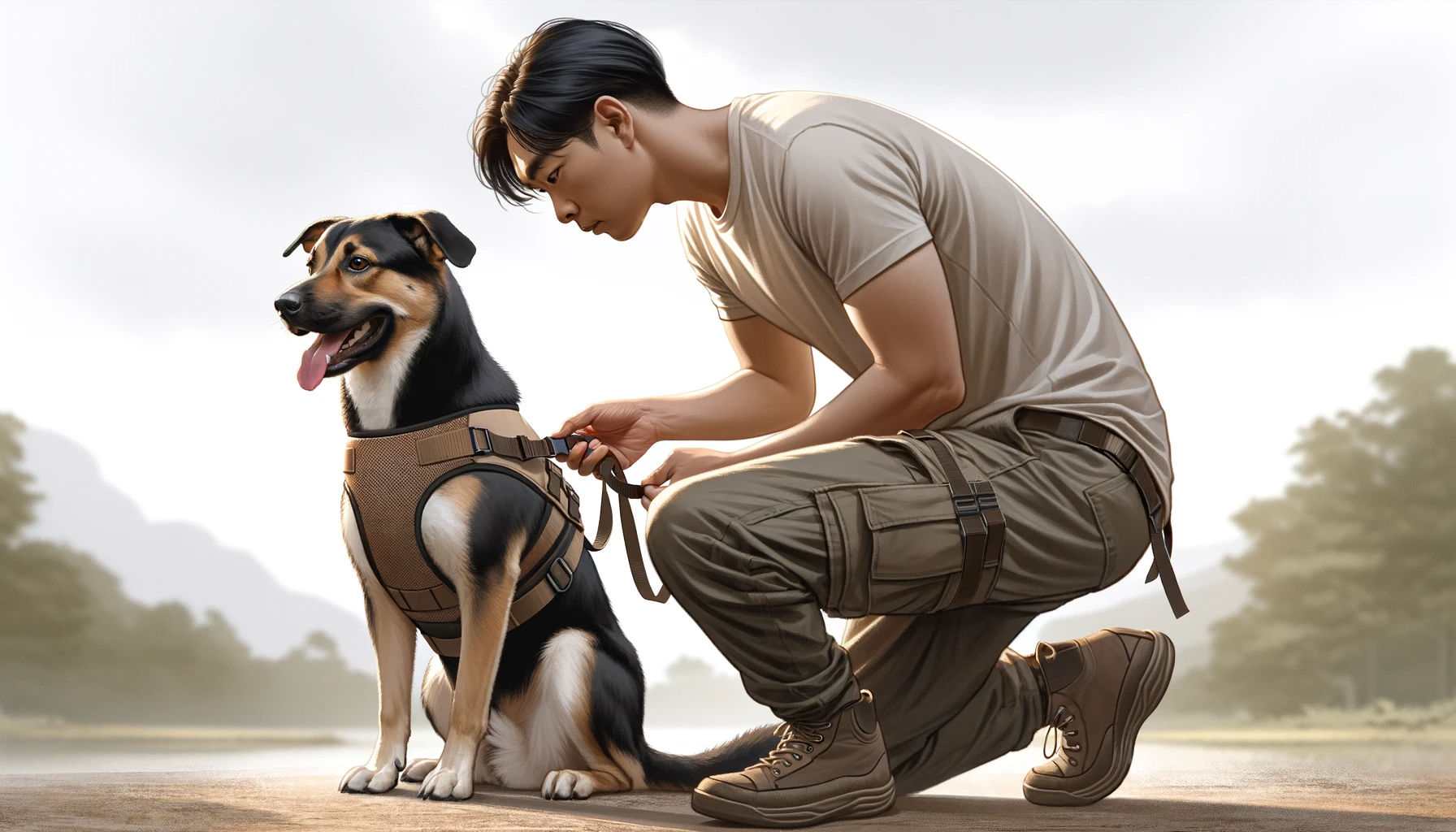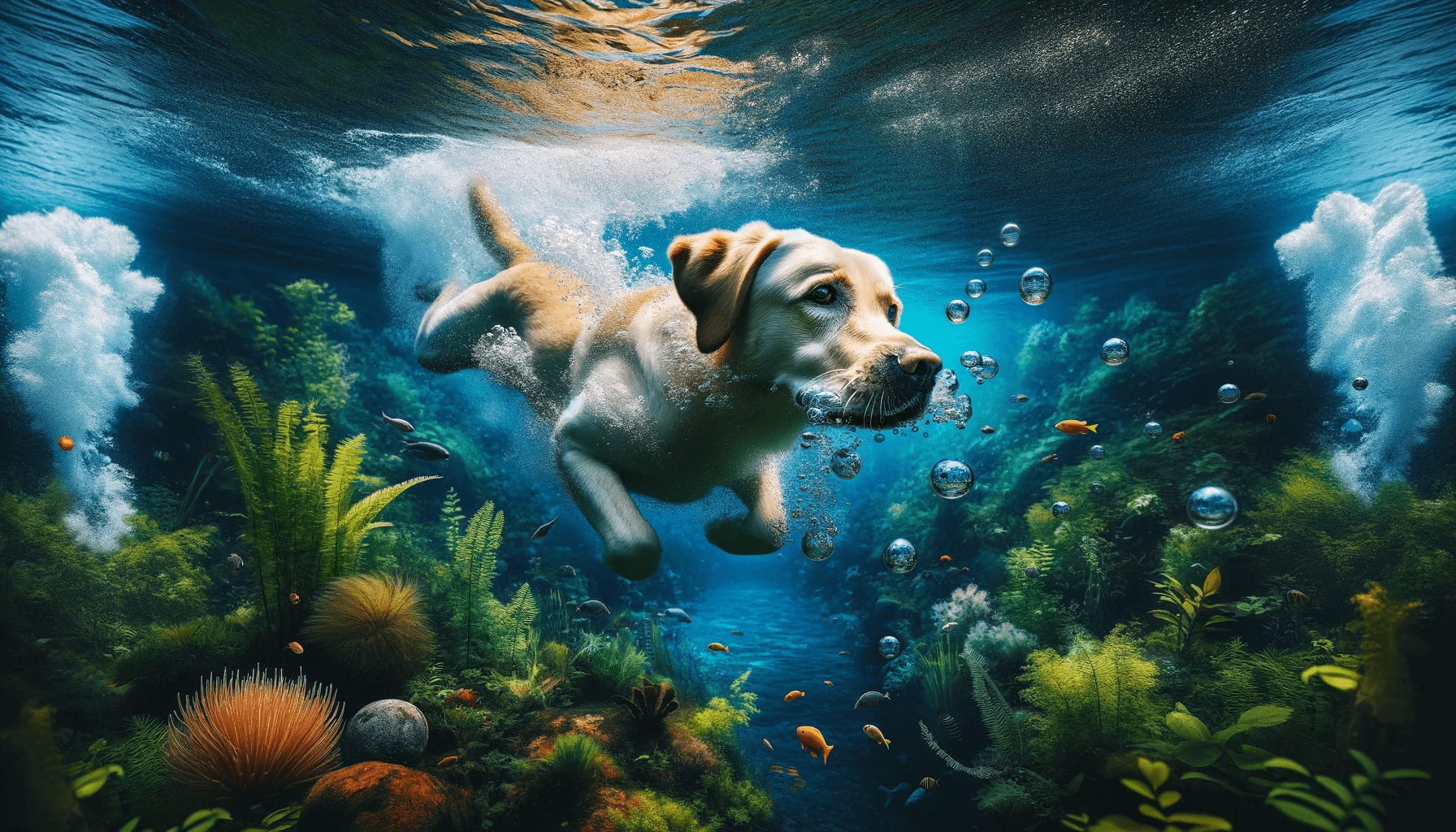Are you struggling to calm your anxious dog?
Discover 15 exercises that can help ease their anxiety and bring them peace.
From walking and jogging to swimming and interactive playtime, there are plenty of activities to engage your furry friend’s mind and body.
You’ll also learn about doga (dog yoga), calming music, and mindfulness exercises that can promote relaxation.
With these techniques, you’ll be able to create a soothing environment for your beloved canine companion.
Key Takeaways
- Physical exercise, such as walking, jogging, hiking, and swimming, can help reduce anxiety levels in dogs.
- Water therapy, including swimming and water-based exercises, provides low-impact exercise, improves muscle strength and flexibility, and helps manage anxiety.
- Mental stimulation activities, such as fetch, tug-of-war, agility training, and puzzle toys, can alleviate anxiety by engaging the senses and redirecting focus.
- Training techniques, like nose work and obedience training, engage natural instincts, provide mental stimulation, and promote obedience and positive behaviors for anxiety relief.
Walking
Take your anxious dog for a daily walk to help reduce their anxiety levels. Walking isn’t only a great way to provide physical exercise for your furry friend, but it also offers mental stimulation and a chance for them to explore their surroundings. When you walk your dog, try incorporating some jogging with a leash to increase the intensity of the exercise. This won’t only burn off excess energy, but it can also help your dog release pent-up anxiety.
During your walks, make sure to provide mental stimulation for your anxious dog. Encourage them to sniff around, explore different routes, and interact with their environment. Allowing your dog to engage with the world around them can help redirect their focus from their anxiety and provide a positive outlet for their energy.
Additionally, maintaining a consistent walking routine can help establish a sense of structure and predictability for your anxious dog. Dogs thrive on routine, and having a regular exercise schedule can give them a sense of security and stability. Aim for at least 30 minutes to an hour of walking each day, depending on your dog’s energy level and fitness level.
Jogging
Ready to take your anxious dog for a jog?
Jogging can be a great way to help your furry friend release excess energy and reduce anxiety.
It’s important to find a pace that suits your dog’s needs, whether it’s a steady jog or a more brisk pace.
Let’s explore the benefits of jogging for your anxious dog.
Pacing Vs. Steady Jogging
Are you wondering which is better for calming your anxious dog: pacing or steady jogging?
Both pacing and steady jogging can be effective in helping to calm your anxious dog, but it ultimately depends on your dog’s individual needs and preferences.
Pacing involves walking at a slower, rhythmic pace, focusing on deep breathing and relaxation techniques. This can help to calm both you and your dog, as you create a calming environment and establish a steady routine.
On the other hand, steady jogging can provide a higher level of physical activity, which can help release excess energy and promote relaxation.
It’s important to gauge your dog’s energy levels and physical abilities to determine which exercise is more suitable. Remember to always start slow and gradually increase the intensity of the exercise to avoid overwhelming your dog.
Benefits of Jogging
Jogging can offer several benefits for your anxious dog, including increased physical activity and a sense of relaxation. Regular jogging sessions can help your dog burn off excess energy and calories, promoting overall physical fitness. By engaging in this activity, your dog’s muscles and joints will be strengthened, leading to improved mobility and flexibility.
Additionally, jogging can have a calming effect on your dog’s mind, reducing anxiety and promoting a sense of relaxation. To further enhance the benefits of jogging, incorporate stretching exercises before and after each session. Stretching helps to prevent muscle strains and injuries, and it also improves your dog’s range of motion.
Consider incorporating interval training into your jogging routine as well, alternating between periods of fast-paced running and slower jogging. This can help to increase your dog’s endurance and stamina over time, while also providing mental stimulation.
Hiking
Grab your leash and take your anxious pup on a refreshing hike through the great outdoors. Hiking isn’t only a great way to bond with your furry friend, but it can also help alleviate their anxiety. Here are a few tips to ensure hiking safety and make the most of your hiking experience with your anxious dog:
- Choose the right trail: Opt for well-maintained trails that are suitable for dogs. Look for trails that offer a mix of shade and open spaces, as well as scenic views to keep your dog engaged and distracted from their anxiety.
- Invest in proper hiking gear: Make sure your dog is wearing a sturdy harness or a well-fitted collar with identification tags. Consider using a leash that allows your dog some freedom to explore but still keeps them under control. Additionally, pack essential items such as water, snacks, waste bags, and a first aid kit.
- Start slow and gradually increase difficulty: Begin with shorter and easier hikes, gradually increasing the distance and difficulty level as your dog becomes more comfortable. This will help build their confidence and reduce anxiety.
Swimming
Swimming can be a great exercise for your anxious dog, providing both physical and mental benefits. Not only does it help to burn off excess energy, but it also promotes relaxation and reduces stress.
However, it’s important to take safety precautions and ensure your dog is comfortable in the water. If swimming isn’t an option, there are alternative water therapies that can also help calm your anxious dog.
Water Therapy Benefits
Immerse your anxious dog in the therapeutic benefits of water, helping them find calm and relaxation. Water therapy is a safe and effective way to alleviate anxiety in dogs, providing numerous benefits for their physical and mental well-being.
Here are three reasons why water therapy can be beneficial for your anxious pup:
- Low-impact exercise: Swimming allows your dog to engage in physical activity without putting excessive strain on their joints. This low-impact exercise helps to improve their muscle strength and flexibility while reducing the risk of injury.
- Mental stimulation: The soothing nature of water can help to distract your dog from their anxious thoughts. Swimming provides a stimulating environment that encourages focus and concentration, helping to divert their attention away from stressors.
- Natural relaxation: The buoyancy of water provides a calming effect on your dog’s body, promoting relaxation and reducing muscle tension. This natural relaxation can help your anxious dog to feel more at ease and alleviate their anxiety symptoms.
Incorporating water therapy into your dog’s routine can be a beneficial tool in managing their anxiety. Remember to always prioritize water therapy safety by providing proper supervision and ensuring your dog is comfortable and enjoying the experience.
Safety Precautions for Swimming
Ensure the safety of your anxious dog while swimming by following these important precautions.
Water safety should be a top priority when introducing your dog to swimming activities. Always supervise your dog closely and never leave them unattended near water, even if they’re wearing swimming equipment.
Invest in a well-fitted life jacket specifically designed for dogs, as it can provide extra buoyancy and help keep them afloat.
Before swimming in unfamiliar waters, assess the conditions, such as currents, water temperature, and depth, to ensure they’re suitable for your dog’s swimming abilities. Avoid areas with strong currents or underwater hazards.
Lastly, gradually introduce your dog to swimming and monitor their comfort level. If your dog shows signs of distress or fatigue, immediately take them out of the water and provide a safe and calm environment.
Alternatives to Swimming
If your anxious dog isn’t comfortable with swimming, there are other activities you can try to help them relax. Not all dogs are fond of water, so it’s important to find alternatives that still provide the benefits of exercise and relaxation.
Here are a few options you can consider:
- Water Aerobics: This low-impact exercise involves gentle movements in the water, which can help your dog build strength and improve their overall well-being. It’s a great option for dogs who may not be comfortable with swimming but still enjoy being in the water.
- Hydrotherapy for Dogs: Hydrotherapy involves controlled exercises in a pool or underwater treadmill specifically designed for dogs. The buoyancy of the water can help relieve joint pain, reduce inflammation, and improve mobility. It’s a fantastic alternative for anxious dogs who may benefit from gentle, therapeutic water-based exercises.
- Interactive Water Toys: If your dog enjoys playing fetch or chasing toys, consider using water toys for interactive play. Throwing a floating toy in a safe, shallow area can provide mental stimulation and help your dog associate water with positive experiences.
Fetch
To calm your anxious dog, try playing a game of fetch with them. Fetch isn’t only a fun activity, but it can also provide mental stimulation for your furry friend. It’s a great way to engage their senses and redirect their focus, helping to alleviate their anxiety.
Playing fetch can be particularly beneficial for puppies in their training phase. It helps them develop their coordination and strengthens their bond with you. By teaching them to fetch and return the toy, you’re also reinforcing their obedience and responsiveness to commands.
The repetitive nature of fetching can be calming for dogs, as it allows them to release pent-up energy and find a sense of purpose. The physical exercise involved in fetching can also tire them out, promoting relaxation and better sleep.
When playing fetch with your dog, make sure to use a toy that they enjoy and feel comfortable with. Start in a quiet and familiar space, gradually increasing the level of distraction as they become more comfortable. Remember to always praise and reward them for their efforts, creating a positive experience that they’ll look forward to.
Tug-of-war
Tug-of-war can be a great way to engage and calm your anxious dog. By using safe techniques, such as using a sturdy toy and teaching your dog to release on command, you can ensure a positive experience for both of you.
The benefits of tug-of-war include mental stimulation, physical exercise, and an opportunity for bonding with your furry friend.
Safe Tug-Of-War Techniques
When engaging in a game of tug-of-war with your anxious dog, ensure you use safe techniques to prevent any accidents or injuries. Tug-of-war can be a great way to provide safe play and mental stimulation for your furry friend.
Here are some tips to make your tug-of-war sessions enjoyable and safe for both you and your dog:
- Use a sturdy tug toy: Make sure the toy you use is designed specifically for tug-of-war and can withstand the pulling and tugging without breaking or causing harm.
- Set boundaries: Teach your dog to understand and respect the rules of the game. Establish cues like ‘take it’ and ‘drop it’ to maintain control and prevent any unwanted behavior.
- Avoid excessive force: Remember that tug-of-war should be a fun and engaging activity, not a test of strength. Use gentle and controlled movements to prevent any strain or injuries.
Benefits of Tug-Of-War
Engaging in a game of tug-of-war with your anxious dog has numerous benefits that can help alleviate their anxiety and provide them with mental and physical stimulation.
Tug-of-war is an excellent way to provide your dog with the mental stimulation they need. The game requires them to strategize and use their problem-solving skills to win the tug-of-war battle. This mental exercise can tire them out and redirect their focus from their anxiety.
Additionally, playing tug-of-war can strengthen the bond between you and your dog. It allows you to engage in interactive play, which promotes trust and communication. Through this game, you can establish yourself as a source of fun and support for your anxious dog, helping them feel more secure and confident.
Agility Training
Get your anxious dog moving and focused with agility training. This activity not only provides physical exercise but also mental stimulation, helping to relieve anxiety and promote a sense of calm in your furry friend.
Here are some agility techniques you can try with your dog:
- Weave Poles: Set up a series of poles and teach your dog to navigate through them in a zigzag pattern. This exercise improves focus, coordination, and flexibility.
- Tunnels: Create a tunnel using collapsible fabric or PVC pipes and encourage your dog to run through it. This activity builds confidence and encourages problem-solving skills.
- Jumping: Set up low hurdles or jumps for your dog to leap over. Start with smaller heights and gradually increase the difficulty. Jumping exercises enhance agility, balance, and strengthen muscles.
To get started with agility training, you’ll need a few basic pieces of equipment:
- Weave Poles: These are vertical poles placed in a straight line or in a pattern for your dog to weave through.
- Tunnels: Collapsible fabric tunnels or PVC pipes are commonly used in agility training.
- Jumps: Adjustable hurdles or jumps are essential for teaching your dog to jump over obstacles.
Puzzle Toys
You can regularly engage your anxious dog with puzzle toys to provide mental stimulation and help alleviate their anxiety. Puzzle toys are interactive toys that require your dog to solve a puzzle in order to access a treat or a reward. These toys can be a great way to keep your dog occupied and entertained, while also helping to relieve their anxiety.
When choosing puzzle toys for your anxious dog, it’s important to read puzzle toy reviews to ensure that the toy is suitable for your dog’s size and skill level. Puzzle toys come in different levels of difficulty, so it’s important to choose one that will challenge your dog without frustrating them.
If you’re feeling creative, you can also try making your own puzzle toys for your dog. DIY puzzle toy ideas include using empty plastic bottles or muffin tins to hide treats, or creating a treat-filled cardboard box with holes for your dog to explore.
Puzzle toys can provide mental stimulation and help alleviate anxiety in your dog. By engaging their mind and challenging their problem-solving skills, puzzle toys can help redirect their anxious energy into a positive outlet. So, give puzzle toys a try and watch your anxious dog find joy and relaxation in the challenge.
Nose Work
Ready to engage your anxious dog in a stimulating activity that will help calm their mind?
Nose work might just be the answer! This exercise not only provides mental stimulation and physical exercise, but it also taps into your dog’s natural instincts.
By using their incredible sense of smell, nose work can benefit your dog in numerous ways.
Let’s explore the benefits of nose work and some training techniques to get started.
Benefits of Nose Work
Discover the numerous benefits of engaging your anxious dog in nose work exercises. Nose work, also known as scent work, is a training method that provides mental stimulation for your furry friend. Here are three reasons why nose work can be beneficial for your anxious dog:
- Mental Stimulation: Nose work engages your dog’s sense of smell, which is highly stimulating and can help redirect their focus from anxiety-inducing thoughts. It keeps their mind active and occupied, reducing stress and promoting relaxation.
- Build Confidence: As your dog successfully finds hidden scents during nose work exercises, they gain a sense of accomplishment and confidence. This can be particularly beneficial for anxious dogs, as it helps boost their self-assurance and overall well-being.
- Physical Exercise: Nose work involves your dog using their nose to search and locate scents, which requires physical movement. This provides a healthy outlet for their energy, helping to reduce anxiety and promote a calmer state of mind.
Engaging your anxious dog in nose work exercises can be a rewarding and effective way to alleviate their anxiety and improve their overall well-being.
Training Techniques for Nose Work
To effectively train your anxious dog in nose work, you’ll need to familiarize yourself with various techniques and methods. Nose work is a great way to engage your dog’s natural instincts and provide mental stimulation.
One training technique is called ‘scent pairing,’ where you introduce a specific scent to your dog, like lavender or anise, and reward them for finding it. This helps them associate the scent with a positive experience.
Another technique is ‘hiding and seeking,’ where you hide treats or toys for your dog to find using their nose. This not only improves their scent detection skills but also builds their confidence.
The benefits of nose work include reducing anxiety, promoting relaxation, and improving focus. By incorporating these training techniques into your dog’s routine, you can help them overcome their anxiety and provide them with a fun and rewarding activity.
Obedience Training
Train your anxious dog to be obedient by consistently practicing commands and reinforcing positive behaviors. Obedience training is an essential part of helping your dog overcome anxiety and feel more secure in their environment. Here are some key techniques to consider:
- Positive reinforcement: Use treats, praise, and rewards to reinforce good behavior. When your dog follows a command correctly, give them immediate positive reinforcement to let them know they did well.
- Consistency: Consistency is crucial in obedience training. Make sure to use the same commands and cues every time, and be consistent in your expectations. This will help your dog understand what’s expected of them and reduce confusion and anxiety.
- Patience and persistence: Obedience training takes time and effort, especially with an anxious dog. Be patient and understanding, and don’t give up if your dog doesn’t catch on right away. Keep practicing and reinforcing positive behaviors consistently.
Massage Therapy
Continue helping your anxious dog feel more secure and relaxed by incorporating massage therapy into their routine. Massage techniques can be a powerful tool for stress reduction in dogs, as it promotes relaxation and releases tension in their muscles. Not only does it provide physical benefits, but it also helps to strengthen the bond between you and your furry friend.
When massaging your dog, start by creating a calm environment. Find a quiet space where you won’t be interrupted, and make sure your dog is comfortable and relaxed. Begin by using gentle, slow strokes on their body, focusing on areas where they hold tension, such as the shoulders, neck, and back.
As you massage, pay attention to your dog’s body language and cues. They may lean into your touch, close their eyes, or let out a sigh, indicating that they’re enjoying the experience. If your dog shows signs of discomfort or stress, adjust your pressure or technique accordingly.
Incorporating massage therapy into your dog’s routine can provide them with a sense of security and relaxation. It’s an effective stress reduction technique that can help them navigate through their anxiety and promote overall well-being. So, take the time to learn and practice these massage techniques, and watch as your dog becomes more at ease and content.
Doga (Dog Yoga)
Incorporating Doga (Dog Yoga) into your routine can further enhance your anxious dog’s sense of security and relaxation. Doga is a practice that involves performing yoga poses and exercises with your dog. It not only benefits your dog’s physical health but also promotes mental well-being.
Here are three doga techniques that can help calm your anxious pup:
- Joint Stretches: Doga involves gentle stretching exercises that can increase your dog’s flexibility and relieve muscle tension. These stretches target the joints, helping to alleviate any stiffness or discomfort your dog may be experiencing.
- Breathing Exercises: Just like humans, dogs can benefit from deep breathing exercises. By teaching your dog to take slow, deep breaths, you can help them relax and reduce anxiety. Encourage your dog to inhale deeply through their nose and exhale slowly through their mouth.
- Partner Poses: Doga often involves practicing yoga poses with your dog. Partner poses such as the ‘downward dog’ or the ‘puppy pose’ can help strengthen the bond between you and your dog while promoting relaxation and calmness.
Calming Music
To help calm your anxious dog, try playing calming music in the background. Calming music for anxious dogs can have numerous benefits and can be a valuable tool in reducing stress and anxiety in your furry friend.
Music has a powerful effect on our emotions, and the same goes for dogs. Calming music has been shown to have a soothing effect on dogs, helping to lower their heart rate, reduce anxiety, and promote relaxation. The soft melodies and gentle rhythms can create a calm and peaceful environment for your dog, making them feel safe and secure.
One of the main benefits of calming music for dogs is its ability to mask external noises that may be triggering their anxiety. Dogs have sensitive hearing and can become easily stressed by loud noises such as thunderstorms or fireworks. By playing calming music, you can help drown out these sounds and create a more serene atmosphere for your dog.
Additionally, calming music can also provide a sense of familiarity and comfort to your dog. Dogs are creatures of habit and often find solace in routines. By playing the same calming music during stressful situations, such as car rides or vet visits, you can help your dog associate the music with a sense of calmness and security.
When choosing calming music for your dog, opt for soft instrumental melodies or classical music. Avoid songs with loud vocals or sharp, sudden sounds, as these can have the opposite effect and increase anxiety. Experiment with different types of music to see what works best for your dog.
Interactive Playtime
Engage with your anxious dog through interactive playtime to help alleviate their stress and anxiety. Dogs, like humans, benefit from physical activity and mental stimulation. Interactive playtime provides an opportunity for your dog to release pent-up energy and channel their focus into a positive and engaging activity.
Here are three calming exercises that you can incorporate into your interactive playtime sessions:
- Hide and Seek: Hide treats or toys around the house or in your yard, and encourage your dog to search for them. This game not only provides mental stimulation but also taps into their natural instinct to forage and explore.
- Puzzle Toys: Invest in puzzle toys that require your dog to work for their treats. These toys can range from simple treat-dispensing balls to more complex puzzles that require problem-solving skills. This type of mental stimulation can help redirect your dog’s anxious thoughts and keep them occupied.
- Tug-of-War: Engaging in a controlled game of tug-of-war can be a great outlet for your dog’s excess energy. It’s important to establish rules and boundaries to prevent the game from becoming too intense. This game can help build a bond between you and your dog while providing a physical and mental workout.
Incorporating these calming exercises into your interactive playtime routine can help reduce anxiety and provide a healthy outlet for your dog’s energy. Remember to always supervise your dog during playtime and tailor the activities to their individual needs and abilities.
Mindfulness Exercises
Practice mindfulness exercises to help calm your anxious dog. Mindfulness exercises can be a beneficial tool in reducing anxiety and promoting relaxation in dogs. These exercises involve focusing your dog’s attention on the present moment and encouraging them to be fully aware of their surroundings.
One effective mindfulness exercise is deep breathing. Take your dog to a quiet, calm environment and sit with them. Gently stroke their fur while taking slow, deep breaths in and out. This rhythmic breathing can help your dog regulate their own breathing and induce a state of calm.
Another mindfulness exercise is body scanning. With your dog lying down, slowly stroke their body from head to tail, paying attention to any areas of tension or discomfort. This gentle touch can help your dog relax and release any built-up stress.
Remember to be patient and give your dog time to adjust to these exercises. Mindfulness exercises, when practiced regularly, can have a positive impact on your dog’s overall well-being and help reduce anxiety.
Frequently Asked Questions
What Are Some Common Signs of Anxiety in Dogs?
Common signs of anxiety in dogs include excessive barking, destructive behavior, trembling, panting, and avoidance. You can identify anxiety in dogs by observing their body language and behavior.
How Often Should I Engage in Interactive Playtime With My Anxious Dog?
Engaging in interactive playtime with your anxious dog is important. You may wonder, how often is enough? It’s recommended to engage in playtime at least once a day to help alleviate their anxiety.
Can Certain Breeds of Dogs Be More Prone to Anxiety?
Certain breeds of dogs can be more prone to anxiety due to genetics. However, the impact of early socialization can play a significant role in managing and reducing anxiety in dogs.
Are There Any Specific Exercises or Activities That Can Help With Separation Anxiety in Dogs?
To help with separation anxiety in dogs, try effective exercises like puzzle toys or obedience training. Create a calm environment by providing a cozy den, soothing music, and gradual departures.
What Are Some Additional Ways to Create a Calm and Relaxing Environment for My Anxious Dog at Home?
To create a calm and relaxing environment for your anxious dog at home, try creating a safe space for them to retreat to. You can also play calming music to help soothe their nerves.
Conclusion
In conclusion, incorporating regular exercise and calming activities into your dog’s routine can greatly help in reducing anxiety levels.
Activities such as walking, jogging, hiking, swimming, and interactive playtime provide mental stimulation and physical release, promoting a sense of calmness in your furry friend.
Additionally, Doga (Dog Yoga), calming music, and mindfulness exercises can further enhance relaxation.
By understanding and addressing your dog’s anxiety, you can create a peaceful and balanced environment for them to thrive in.





